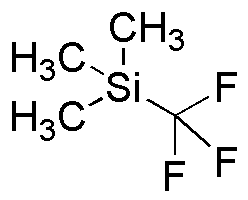Trimethyl(trifluoromethyl)silane is widely utilized in research focused on:
- Organic Synthesis: This compound serves as a versatile reagent in organic chemistry, particularly in the synthesis of fluorinated organic compounds, which are crucial in pharmaceuticals and agrochemicals.
- Silicon-Based Materials: It is employed in the production of silicon-containing materials, enhancing properties such as thermal stability and chemical resistance, making it valuable in the electronics and automotive industries.
- Fluorination Reactions: The compound is used in selective fluorination processes, allowing researchers to introduce fluorine atoms into organic molecules, which can improve their biological activity and stability.
- Surface Modification: In material science, it aids in modifying surfaces to achieve desired hydrophobic or oleophobic properties, beneficial for coatings and sealants in construction and manufacturing.
- Analytical Chemistry: It acts as a derivatizing agent in analytical methods, improving the detection and quantification of various compounds in complex mixtures, which is essential in environmental monitoring and quality control.
General Information
Properties
Safety and Regulations
Applications
Trimethyl(trifluoromethyl)silane is widely utilized in research focused on:
- Organic Synthesis: This compound serves as a versatile reagent in organic chemistry, particularly in the synthesis of fluorinated organic compounds, which are crucial in pharmaceuticals and agrochemicals.
- Silicon-Based Materials: It is employed in the production of silicon-containing materials, enhancing properties such as thermal stability and chemical resistance, making it valuable in the electronics and automotive industries.
- Fluorination Reactions: The compound is used in selective fluorination processes, allowing researchers to introduce fluorine atoms into organic molecules, which can improve their biological activity and stability.
- Surface Modification: In material science, it aids in modifying surfaces to achieve desired hydrophobic or oleophobic properties, beneficial for coatings and sealants in construction and manufacturing.
- Analytical Chemistry: It acts as a derivatizing agent in analytical methods, improving the detection and quantification of various compounds in complex mixtures, which is essential in environmental monitoring and quality control.
Documents
Safety Data Sheets (SDS)
The SDS provides comprehensive safety information on handling, storage, and disposal of the product.
Product Specification (PS)
The PS provides a comprehensive breakdown of the product’s properties, including chemical composition, physical state, purity, and storage requirements. It also details acceptable quality ranges and the product's intended applications.
Certificates of Analysis (COA)
Search for Certificates of Analysis (COA) by entering the products Lot Number. Lot and Batch Numbers can be found on a product’s label following the words ‘Lot’ or ‘Batch’.
*Catalog Number
*Lot Number
Certificates Of Origin (COO)
This COO confirms the country where the product was manufactured, and also details the materials and components used in it and whether it is derived from natural, synthetic, or other specific sources. This certificate may be required for customs, trade, and regulatory compliance.
*Catalog Number
*Lot Number
Safety Data Sheets (SDS)
The SDS provides comprehensive safety information on handling, storage, and disposal of the product.
DownloadProduct Specification (PS)
The PS provides a comprehensive breakdown of the product’s properties, including chemical composition, physical state, purity, and storage requirements. It also details acceptable quality ranges and the product's intended applications.
DownloadCertificates of Analysis (COA)
Search for Certificates of Analysis (COA) by entering the products Lot Number. Lot and Batch Numbers can be found on a product’s label following the words ‘Lot’ or ‘Batch’.
*Catalog Number
*Lot Number
Certificates Of Origin (COO)
This COO confirms the country where the product was manufactured, and also details the materials and components used in it and whether it is derived from natural, synthetic, or other specific sources. This certificate may be required for customs, trade, and regulatory compliance.


